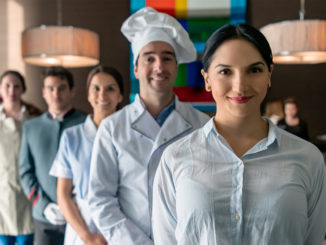Times continue to be tough. Inflation is at an all-time high and margins are getting tighter and tighter. “How can we continue to offer the same level of service and deliverables to our guests as expected, when costs are out of control?”
This question is being asked by so many of our clients, with only the most creative leaders finding solutions. The answer is offering what your guests expect, in a manner that maintains respectable profitability, while maintaining “who you are.”
Let’s Look at the Data
Traditional Food and Beverage data suggested that good businesses run 30/30/30/10 margins:
- 30% Blended Food and Beverage Cost
- 30% Labor Cost
- 30% Other Costs
- 10% Profit
We started to see a change pre-COVID-19 to 35/40/20/5:
- 35% F&B Cost
- 40% Labor Cost
- 20% Other Costs
This left margins for restaurants around five percent if successful.
Now, Post-COVID-19 or “COVID-19-Normal” – margin costs are still increasing in many markets. This meant the cost of food and beverages, along with the increased cost of transportation to get the product, went up to 35 percent or higher, requiring operations to drastically reduce menu quality, offerings, or portion sizes, while also adjusting the menu prices to protect a proper margin.
In addition, labor costs were no longer 30%, and most operations had to get creative with staffing to keep it down below 40% of total revenue. Other costs logically had to go down, which dramatically impacted the quality perception of the restaurant or bar. Other expenses included things like menu costs, marketing, disposables associated with serving food or beverages, linen expenses, uniform expenses, utilities in some cases, and cleaning costs.
Those margins left most restaurants earning a mere five percent to the bottom line – and that is if you control your costs above and have no theft or waste.
Post-COVID-19 or the new “COVID-19-Normal” has continued to strain these margins, and many operators are wondering how they can survive. Continuing to raise the menu prices has an inelastic effect. At some point – you lose guests as they are not willing to pay more for less. Insurance costs, costs of wages, costs to hire and rehire are all out of control in every sector. Creativity continues to be the answer.
Doing More with Less
As employment costs are now the highest category of expense, let’s look just at just the labor aspect, creatively offering food and beverage service with fewer team members.
- Eliminate the unnecessary. I know that sounds like a “duh” statement, but it’s harder to implement, especially in a tenured, union or Tribal setting where employment is not negotiable. In this case – eliminate the title. No longer is one person a server, a host, expeditor or busser. All are restaurant team members who perform “duties as assigned.” With proper training and a team mentality, a restaurant can function with only one class of team member. Back of house team members might be more difficult to combine, but the simplification of your mise-en-place and rightsizing of your menu offerings might make the kitchen team more efficient. Don’t make sauces and products that can be effectively purchased from your supplier. Watch your waste and return plates to see what is not being used or consumed by your guests and eliminate items. As an example, many restaurants changed bread service or chips and salsa to request only, which for a nominal cost effectively reduced waste and time required to automatically deliver items without revenue.
- Rebrand yourself. Often the restaurant does what it always does because that’s what it has always done. Invest time in understanding what is most important for your guests. Sometimes change is the exact answer to solving a deliverable issue. Could it be that your guests want less service, but a more affordable and simpler menu? Is time the most important deliverable they expect, so a long service takes them away from the gaming floor or other entertainment? When was the last time you asked your guests what they wanted?
- Invest in training or retraining. This does not need to be expensive, but it could give you a significant return. The use of standard training manuals and steps (or sequences) of service are only as good as the supervision of said standards. You must “inspect what is expected” of your team, and good supervisor training is crucial to that success. Service training and selling techniques may improve sales and make your front of house team more efficient. The simplest and easiest is the “no empty hands” rule. Managing the expectation that your front of house team doesn’t go anywhere with empty hands, makes them think more efficiently and more like a team. Coming or going they are looking to pick up a plate, refill beverages or deliver a dish – REGARDLESS of whether it is their table. There are many training gems that can be taught to improve labor costs.
- Use available technology. Many point-of-sale systems have wireless technology available now where the server can take an order, look up preparation instructions, ingredients and allergens, view a picture of the plate, convey kitchen and delivery information, and settle the check all from a handheld device. This is not only effective, but it can be significantly more efficient than traditional methods – and it is cool. Many restaurants in the new “COVID-19-Normal” have eliminated or drastically reduced the presentation of a tactile menu and instead offer QR codes tableside for guests to look up current menus on their personal devices. Some older guests have resisted this trend, but most are accepting of this and it eliminated the cost of paper menus. Marketing can be linked to this service and bounce back offers can be given with tracers to know how effective promotions are. Back of house use of KDS (Kitchen Display Systems) that are tied to the POS allow the cooks and expeditors to graphically view next and upcoming orders with ease, eliminating laser printers and discussion points between servers and kitchen crew.
- Future tech. How creative can you see yourself being in the future? Some restaurants have implemented robots to seat, deliver food and/or beverages, and answer questions as a virtual concierge for your restaurant or entire property. The Jetsons’ future is only 40 years away from space travel, sky walkways, floating cars and instant food with the push of a button. Marty McFly got it wrong in the year 2015 for Back to the Future Part II – we missed many of those trends, but food seems to be the one area that came close. For example, a pizza re-hydrator for instant, hot pizza and a retractable garden for fresh fruits and vegetables. In the movie Passengers, set 500 years in the future, Jim and Aurora get the meals of their choice – but based on their purchased cruise package. Jim’s is significantly lower than Aurora’s Gold Package, and he’s unable to have a gourmet breakfast. It could be that players’ tiers would change their menu offerings should you install futuristic food creation machines. How creative would that be? No labor cost front or back of house.
Seriously though, there are many ways to do more with less without waiting for Star Trek to become our new normal.





